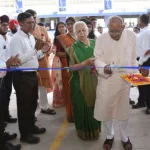Traditional banarasi/pochampalli and Indian tussar silk are not on the verge of closure in the country. However, the Government of India has been implementing various schemes for overall development and promotion of the handloom sector including weavers of traditional Varanasi/pochampalli and Indian tussar silk.The demand for Indian tasar silk has increased substantially during the last three years. The XI Plan witnessed spectacular growth in tasar silk production, particularly tasar as given in Annexure-2. Export Earnings from export of tasar silk goods during last three years was Rs.219.71 Crore in 2010-11, Rs. 289.56 Crore in 2011-12 and Rs. 290.04 Crore in 2012-13. The Government has taken several steps to increase the production of tussar silk and provided incentives to silk industries for the promotion of silk exports.
Under Quality Certification system, Silk Mark Organisation of India (SMOI) during the last three years has organized 49 Silk Exhibitions in the country at different places: 17 in 2010-11, 17 in 2011-12 and 15 in 2012-13. SMOI has planned to organise about 18 Silk Mark Exhibitions/ Expositions in different parts of the country during the current financial year 2013-14. In addition to this, Indian Silk Export Promotion Council (ISEPC) has also organised Silk Exhibitions namely, Silk Paradise in July 2009, January 2010 and July 2011.
Further, one Handloom Park at Pochampalli under the Scheme for Integrated Textile Parks (SITP) having designing, dyeing and weaving facility for textiles/ silk under a single roof has also been established. One Mega Handloom Cluster at Varanasi with Government of India share of Rs. 70 crore covering more than 25,000 handloom weavres has been taken up for integrated and holistic development of handlooms of Varanasi.
In order to arrest decline of handloom silk weaving in these Clusters, Government of India through Central Silk Board (CSB) is providing assistance to both Uttar Pradesh & Andhra Pradesh for development of silk weaving sector in Varanasi and Pochampally areas for implementing different post-cocoon sector scheme viz. support to establishing shuttleless looms, loom up-gradation, certified handlooms especially designed for silk, computer aided Textile Designing, setting up of Common Facility Centre for yarn dyeing and fabric processing etc. During XI Plan period support provided to handloom clusters of Uttar Pradesh (Varanasi) and Andhra Pradesh (Pochampally) under CDP was Rs. 947.69 Lakhs and Rs.660.54 Lakhs respectively.
In order to promote cultivation of tasar food plants, Government of India through Central Silk Board (CSB) implemented a Centrally Sponsored Scheme viz “Catalytic Development Programme” (CDP) during the XI Plan period, in collaboration with all the State Sericulture Departments. Under this scheme, financial assistance is provided to the stakeholders of silk industry through the respective Directors of Sericulture. Further, to boost the production of Tasar silk in the country, special sericulture projects were also implemented through Cluster approach, under Cluster Development Programme. CSB in co-ordination with State Sericulture Departments have jointly developed 7 Clusters exclusively for tasar development under Vanya sector – 2 each in Manipur & Odisha and 1 each in Uttarakhand, Himachal Pradesh and Chattisgarh States.
The production of tasar silk in the country during the last three years was 1166 MTs in 2010-11, 1500 MTs in 2011-12, 1705 MTs in 2012-13.
The Indian Silk Export Promotion Council help the exporting community by promotion of their products through participation in trade fairs, trade delegations, organizing Buyer-Seller Meets, conferences, seminars etc. under MDA/MAI schemes of Government of India.
Government of India through Central Silk Board has also taken steps for silk export viz. development of new variety of silk producing exportable grade silk, development of improved devices, new machines &equipments helping improvement in silk quality and productivity etc. Further, Government has rationalised value addition/ input- output norms specified under the EXIM policy extended to the exporters The facility of duty free import of raw material under the Advanced Licencing Scheme, import of capital goods at concessional rate of duty for export products. Import duty on silk machinery has been reduced to 10%. In recent Foreign Trade Policy Manual, certain silk item have been included in Focus Product Scheme for 5% benefit.
This above information is based on a written reply given by the Minister of State in the Ministry of Textiles, Smt. Panabaaka Lakshmi in the Lok Sabha recently.





